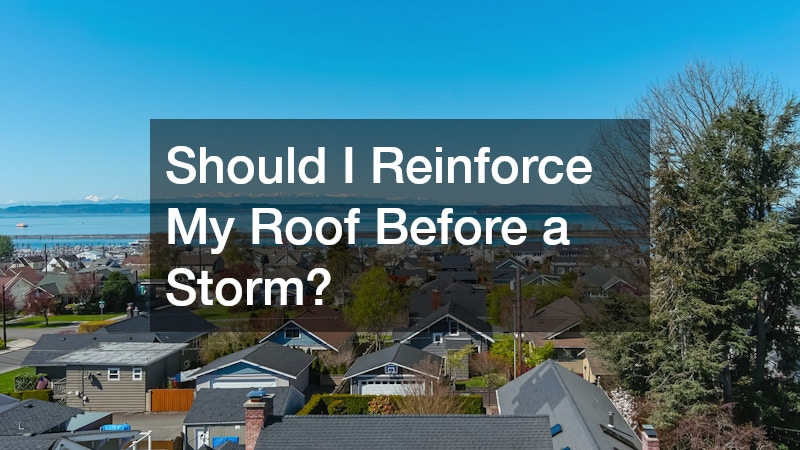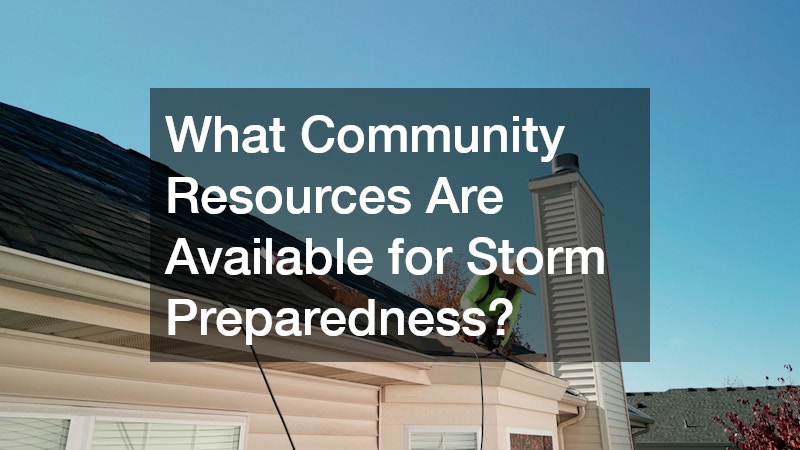Storms can wreak havoc on homes, causing costly damage and creating stressful situations for homeowners. The key to minimizing this risk lies in proper storm-proofing, especially focusing on the roof — the most vulnerable and vital part of any home’s structure. Local roofers have spent years perfecting techniques and strategies that make roofs durable enough to withstand heavy winds, torrential rains, and flying debris. Their expertise blends material selection, structural design, maintenance, and reinforcement methods tailored to the specific climate and conditions of the region.
In this article, we delve into the storm-proofing secrets local roofers rely on to protect homes. From choosing the right materials to understanding roof pitch and ventilation, we cover essential factors that contribute to a storm-resistant roof. Additionally, we discuss how to find a reputable roofing company, the costs involved, and the role of maintenance. Whether you’re a homeowner gearing up for hurricane season or simply curious about how local roofing pros do their job, this comprehensive guide offers valuable insights. Plus, we touch on garage door services and door installation considerations, which are also critical elements in overall storm resilience.
What Materials Are Best for Storm-Proof Roofing?

Metal Roofing
Metal roofing has become a top choice for storm-proof roofs due to its exceptional durability and resistance to harsh weather. Local roofers frequently recommend metal roofers for areas prone to hurricanes and high winds because metal panels withstand impact better than many alternatives. These roofs are less likely to crack, warp, or blow off during storms. Metal roofing materials, such as steel or aluminum, also resist corrosion and last longer with minimal maintenance. Their lightweight nature reduces stress on the structure, making them ideal for reinforcing older homes.
Asphalt Shingles
Asphalt shingles remain one of the most popular roofing materials due to affordability and ease of installation. However, local roofing experts note that standard asphalt shingles vary in quality and performance when facing severe weather. Impact-resistant shingles with higher wind ratings offer better protection but still fall short of metal roofing’s longevity. Proper installation by experienced roofers is essential to ensure shingles remain secure during storms. Homeowners must weigh the cost benefits against the potential need for more frequent repairs or replacements.
Tile and Slate Roofs
Garage door services are your first line of defense. A good local garage door company is a must-have for any homeowner. Tile and slate roofs offer natural beauty and excellent durability, especially against water damage. Local roofers often install these materials in regions where heavy rainfall and storms are common. Both tile and slate have high resistance to fire and wind uplift but can be vulnerable to impact damage if large debris hits the surface. Due to their weight, tile and slate roofs require reinforced framing and professional installation to maintain structural integrity during storms. Despite higher upfront costs, these materials provide long-term benefits in terms of aesthetics and resilience.
How Important Is Roof Pitch in Storm-Proofing?
Understanding Roof Pitch
Roof pitch refers to the angle or slope of a roof, typically expressed as a ratio of rise over run. It is a crucial element local roofers evaluate when designing storm-proof roofing systems. A steeper pitch can facilitate quicker water runoff, reducing the chance of leaks and water infiltration during heavy rain. Conversely, flatter roofs might struggle with water pooling, increasing vulnerability.
Impacts on Water Drainage
During storms, efficient water drainage is critical to preventing roof damage. Roof pitch affects how fast water moves off the surface and into gutters or drainage systems. Local roofing professionals recommend specific pitch ranges depending on the roofing material and climate. For example, metal roofers suggest steeper pitches for better runoff, while asphalt shingles may require moderate slopes for optimal performance.
Best Practices for Roof Pitch
Local roofers advocate for tailoring roof pitch based on regional weather patterns. In hurricane-prone areas, a pitch between 4:12 and 6:12 offers a balance of wind resistance and water drainage. Steeper roofs can be more susceptible to wind uplift but better for snow shedding in colder climates. Collaborating with experienced local roofers ensures your home’s roof pitch is optimized to withstand specific storm risks.
What Role Does Ventilation Play in Storm-Proofing?
Preventing Moisture Buildup
Ventilation is a frequently overlooked but vital aspect of storm-proof roofing. Proper airflow under the roof deck prevents moisture buildup, which can lead to mold, rot, and structural weakening—problems that local roofing experts say significantly reduce roof lifespan. In storm conditions, trapped moisture can exacerbate damage and accelerate deterioration.
Heat Regulation
Effective ventilation also helps regulate heat in the attic, preventing excessive temperatures that can degrade roofing materials over time. Local roofers emphasize that cooler attic spaces improve overall roof performance and energy efficiency, especially during hot summer storms.
Types of Ventilation Systems
There are several ventilation options local roofers utilize to enhance storm readiness, including ridge vents, soffit vents, and turbine vents. Combining intake and exhaust vents ensures balanced airflow, reducing pressure buildup that can lift shingles during high winds. A well-ventilated roof supports both longevity and resilience against storm damage.
Should I Reinforce My Roof Before a Storm?

Signs Your Roof Needs Reinforcement
Local roofers recommend inspecting your roof annually to identify areas needing reinforcement. Signs include loose or missing shingles, deteriorated flashing, sagging sections, or water stains inside the home. If your roof is aging or has endured previous storms, reinforcement may be necessary to prepare for upcoming weather threats.
Methods of Reinforcement
Common reinforcement techniques involve adding hurricane straps, upgrading to impact-resistant shingles, reinforcing fascia boards, and securing roof decking with additional nails or screws. Metal roofers often install interlocking panels for extra strength. These measures improve resistance to wind uplift and flying debris, key factors in storm damage.
Benefits of Reinforcement
Reinforced roofs offer peace of mind and potentially lower insurance premiums. Local roofing professionals note that the upfront investment in strengthening your roof can save thousands in repairs and reduce downtime after storms. A robust roof also maintains the home’s structural integrity, protecting occupants and belongings.
Are There Specific Roofing Designs That Handle Storms Better?
Gable vs. Hip Roofs
Gable roofs, with their two sloping sides, are popular for their simplicity but can be vulnerable to wind damage if not properly braced. Hip roofs, which slope on all four sides, are generally more aerodynamic and provide better resistance to high winds. Local roofers often recommend hip roofs in storm-prone regions because they reduce uplift forces.
Low-Slope vs. Steep-Slope Designs
Low-slope roofs tend to perform well in heavy rain scenarios due to their ability to shed water slowly and evenly but require specialized materials and installation to prevent leaks. Steep-slope roofs offer quick runoff but can be more susceptible to wind damage. The choice depends on climate and architectural style, and local roofing experts can guide homeowners to the best fit.
Custom Architectural Features
Innovative features like curved roofs, wind deflectors, and reinforced eaves add to storm resilience. Some local roofers collaborate with architects to integrate these elements, enhancing both aesthetics and durability. Custom designs can optimize wind flow and minimize pressure points that cause damage.
How Can I Choose a Storm-Proof Roofing Contractor?
Evaluating Experience and Qualifications
Choosing the right roofing company is critical when preparing your home for storms. Local roofers with extensive experience in storm-prone areas bring specialized knowledge of materials, installation techniques, and local building codes. Verify that contractors are licensed and insured. Ask about certifications, such as those from roofing manufacturers or professional associations, which indicate a commitment to quality.
Importance of Local Knowledge
Hiring local roofers has significant advantages. They understand the regional climate patterns, common storm risks, and community-specific regulations. This insight helps them recommend the best storm-proof roofing options tailored to your location. Local roofing companies are also more responsive for inspections, emergency repairs, and warranty work.
Checking References and Reviews
Before hiring, check references and read online reviews to assess a roofing company’s reputation. Trusted local roofers will have positive feedback from satisfied customers and a portfolio of completed projects. Don’t hesitate to ask for examples of previous storm-proofing jobs and any guarantees they provide.
What Is the Cost of Storm-Proof Roofing Solutions?

Initial Investment vs. Long-Term Savings
Storm-proof roofing often requires a higher upfront investment, especially when choosing premium materials like metal or reinforced tile. However, local roofers emphasize that these costs translate into long-term savings by reducing frequent repairs and potential storm damage. The durability of storm-resistant roofs means fewer replacements and less disruption over time.
Insurance Benefits
Many insurance companies offer discounts for homes with certified storm-proof roofs. Upgrading your roof with the help of local roofers can lower premiums and qualify you for special programs. Some insurers require proof of proper reinforcement and materials, so maintaining documentation and permits from your roofing company is essential.
Cost-Benefit Analysis
When considering storm-proof roofing, analyze the costs against the benefits, including increased property value, reduced risk, and peace of mind. Local roofers can provide detailed estimates and explain how different options fit your budget and protection needs. Prioritizing quality over initial price often results in better overall value.
What Maintenance Is Required for Storm-Proof Roofs?
Regular Inspections
Routine inspections by local roofers ensure that your roof remains in top condition. They can identify wear, loose shingles, or damage early, preventing more serious problems. After storms, inspections are especially important to check for hidden issues caused by wind or debris.
Cleaning and Debris Removal
Accumulated leaves, branches, and dirt can clog gutters and damage roofing materials. Local roofers advise regular cleaning to maintain water flow and prevent moisture buildup. Clearing debris also minimizes the risk of damage from heavy rain or wind.
Seasonal Maintenance Tips
Seasonal maintenance includes tightening loose fixtures before storm season, checking flashing around chimneys and vents, and clearing gutters ahead of heavy rains. Local roofers can provide customized maintenance plans to keep your roof storm-ready year-round.
Can Roof Coatings Enhance Storm Readiness?
Types of Roof Coatings
Roof coatings come in various forms, including elastomeric, acrylic, silicone, and polyurethane. Aside from a good door installation, these coatings create a protective barrier that resists water penetration, UV damage, and temperature fluctuations. Local roofing professionals often recommend specific coatings based on your roof’s material and storm risks.
Benefits of Roof Coating
Applying a quality roof coating can extend the life of your roof by preventing leaks and reducing wear. Coatings add an extra layer of protection against wind-driven rain and help maintain the roof’s integrity during storms. Additionally, some coatings improve energy efficiency by reflecting sunlight.
Application Process
Roof coatings require professional application to ensure even coverage and adhesion. Local roofers prepare the surface by cleaning and repairing any damage before applying the coating. Proper maintenance after application helps sustain the coating’s effectiveness over time.
What Community Resources Are Available for Storm Preparedness?

Local Government Programs
Many local governments offer programs and incentives for storm preparedness, including grants or rebates for storm-proof roofing upgrades. Local roofers often partner with these initiatives to help homeowners access resources that reduce upgrade costs.
Educational Workshops
Community workshops provide valuable information on storm-proofing homes, including how to choose hurricane proof windows and reinforce doors. Attending these sessions helps homeowners make informed decisions and connect with trusted local roofing and garage door companies.
Networking with Neighbors
Building a neighborhood network enhances preparedness. Sharing recommendations for reliable local roofers and garage door replacement services or coordinating group discounts can make storm-proofing more affordable. Community support also provides assistance during and after storms.
Conclusion
Storm-proofing your roof is an essential investment for any homeowner in regions prone to severe weather. Local roofers combine their expertise with quality materials, optimal designs, and proactive maintenance to build roofs that stand strong against storms. Understanding factors like material choice, roof pitch, ventilation, and reinforcement empowers you to make informed decisions that protect your home and family.
Choosing a qualified local roofing company is equally crucial. Their knowledge of the area’s weather patterns and building codes ensures your roof meets or exceeds standards for resilience. Additionally, exploring garage door repair services and door installation as part of your storm preparedness completes the protective envelope around your home.
While the initial costs of storm-proofing may seem high, long-term savings from avoided damage and insurance benefits make it worthwhile. Regular inspections, maintenance, and community engagement further enhance your home’s defense against nature’s challenges. Don’t wait for the next storm to strike—consult with trusted local roofers today and secure your home with the best storm-proofing strategies available.

